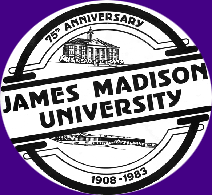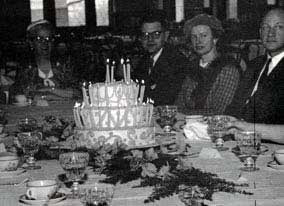James Madison University 's Centennial observance in 2007-2008 clearly promises to be the largest and grandest celebration in the institution's history but it won't be the first time that an anniversary has been observed on campus.
Anniversary celebrations of varying sizes were held for the University's 20th, 25th, 50th and 75th birthday.
75th Anniversary
 |
|---|
The 75th anniversary – JMU's Diamond Anniversary – was by far the largest anniversary celebration prior to the Centennial.
The 1983 celebration was directed and planned by Vice President for University Relations Ray V. Sonner and had “New Horizons for Excellence” at its theme. The celebration got under way on Sunday, March 13, when about 1,000 people attended a $75-a-couple banquet in Gibbons Dining Hall.
The evening banquet was followed by an address in Wilson Hall Auditorium by JMU President Ronald E. Carrier who gave an overview of the university's past, present and future.
A new musical composition by a JMU faculty member was performed for the first time publicly at the anniversary banquet. The composition, titled “Valley Ayres,” was written by Dr. James R. Riley of the JMU music department. (Riley also wrote the current JMU alma mater.)
Several groups of alumni in different locations about the country held anniversary celebrations in their homes simultaneously with the banquet on campus. Taped messages from President Carrier to alumni were available for those meetings.
The following day – the 75th anniversary of the date on which Governor Claude A. Swanson signed the bill which created what is now JMU – the anniversary Founders Day program was held in the JMU Convocation Center with Governor Charles S. Robb giving the keynote address. (Founders Day was celebrated annually at JMU from the school's early years until 2000 when it was replaced by James Madison Day.)
A highlight of the 75th anniversary program was the presentation of JMU's first three honorary doctoral degrees. The first honorary degree, a doctor of laws, went to Governor Robb. Honorary doctor of laws degrees also went to Wallace L. Chandler, a former rector of the JMU Board of Visitors (Chandler Hall is named for him) and A.E. Dick Howard, a University of Virginia law professor and expert on the U.S. Constitution. (Currently, JMU has awarded a total of 25 honorary doctorates.)
 The evening of March 14 there was a well-attended celebration in Godwin Hall featuring a 250-pound birthday cake that was cut by President and Mrs. Carrier.
The evening of March 14 there was a well-attended celebration in Godwin Hall featuring a 250-pound birthday cake that was cut by President and Mrs. Carrier.
On March 15, Howard delivered an address on “James Madison and the Constitution” at the Grafton-Stovall Theatre.
A special feature of the 75th anniversary was the appointment of an Honorary Committee composed of dignitaries who had visited JMU in the past. The list included politicians, famous actors, scholars and other special friends of the University. (For details, see JMU's 75th Anniversary Honorary Committee.)
In conjunction with the anniversary, Images of James Madison University: 1908-1983, an award-winning pictorial history of the university, was published. The Harrisonburg Daily News-Record published a 28-page special supplement written by JMU staff members.
50th Anniversary
 |
|---|
|
Dr. Raymond and Emily Dingledine Jr. (center of photo) were among the guests at the College's 50th anniversary celebration. Dr. Dingledine was a history professor and wrote the history of Madison's first 50 years.
|
Like the Centennial celebration, the Golden Anniversary was a yearlong observance but it began on the school's anniversary date and ran through the following year.
At the 1958 Founders Day program, Madison College professor and author Raymond C. Dingledine gave the keynote address, “Madison College: The Heritage of Her Past.”
The ceremony also included a tribute to State Senator George B. Keezell of Rockingham County who had led the fight in 1908 to have the Normal School located in Harrisonburg.
In the summer of 1958, Madison College 's half-century of institutional growth was honored at the 15th annual Virginia Institute on Public Education meeting. The 1958 events were capped by a Fall Science Fair.
The 1959 portion of the golden anniversary program included the March 13 dedication of six new campus buildings. The six included three residence halls – Logan, Wayland and Gifford halls – along with Burruss Hall, the College Infirmary and Anthony-Seeger Campus Schools. The six buildings had been constructed between 1951 and 1959.
At the Founders Day program on March 14, Dr. Dingledine introduced his recently published book, Madison College : The First Fifty Years, 1908-1958.
A week-long Social Sciences symposium culminated that evening with “Emerging Horizons in an Age of Science,” a set of two speeches by Dr. Robert Charpie, Assistant Director of the Oak Ridge National Lab, and anthropologist Francis Ashley Montagu. Both scientists addressed national and international problems brought about by scientific developments.
In the news media, Madison College's half-century of achievements was recognized by five radio broadcasts, two television shows, and a special issue of the Harrisonburg Daily News Record which included over forty articles on the celebration and the college's past.
25th Anniversary
 |
|---|
| This portrait of State Senator George Keezell was hung in Wilson Hall Auditorium as part of the institution's 25th anniversary celebration on March 17, 1933. The portrait, along with one of President Woodrow Wilson, still hangs in the auditorium. |
E. Lee Trinkle, president of the State Board of Education and former Virginia governor, presided over events on March 17, 1933, when the State Teachers College at Harrisonburg opened its Silver Anniversary celebration with a Founders Day program in Wilson Hall Auditorium.
The keynote speaker at the Founders Day was Bruce R. Payne, president of the George Peabody College for Teachers at Vanderbilt University. More than 1,000 educators and alumni attended the program.
Another speaker was former Virginia governor, Harry F. Byrd. Earlier in March, Byrd had been appointed a U.S. Senator, beginning 32 years of service in the Senate.
Also speaking was the first president of the State Normal and Industrial School for Women at Harrisonburg, Julian A. Burruss, who was then president of Virginia Polytechnic Institute (Virginia Tech).
March 18, which was also Homecoming Day, was devoted to an alumnae program in Wilson Auditorium. Mrs. Johnston Fristoe, President of the Alumnae Association, presided over a series of addresses by noted alumnae of the institution.
The program also featured the presentation of a painting of the late Senator George B. Keezell to the college. The portrait, donated by the Class of 1932 and painted by Helen Wagner Spotswood, was unveiled by Senator Keezell's granddaughter, Cornelia Catherine Simms.
Keezell was a leader in the State Senate and a key advocate in the selection of Harrisonburg as the site of a new state teachers college in 1908. His portrait hangs today in Wilson Hall Auditorium, along with a painting of President Woodrow Wilson.
20th Anniversary
The 20th anniversary of the founding of the State Normal and Industrial for Women at Harrisonburg was held on March 14, 1928, in the gymnasium of Reed Hall (now Keezell Hall) with President Samuel Page Duke presiding.
The main addresses were given by former State Senator George B. Keezell, who had led the fight to locate the school in Harrisonburg, and the institution's first president, Julian A. Burruss. Burruss was then president of Virginia Polytechnic Institute (Virginia Tech).
A member of the school's first faculty, Elizabeth Cleveland, spoke on “Some Reflections of Early Days.” A number of special guests greeted the assembly, including Harrisonburg Mayor Sheffey L. Devier, state officials and local civic leaders.
– August Smith
